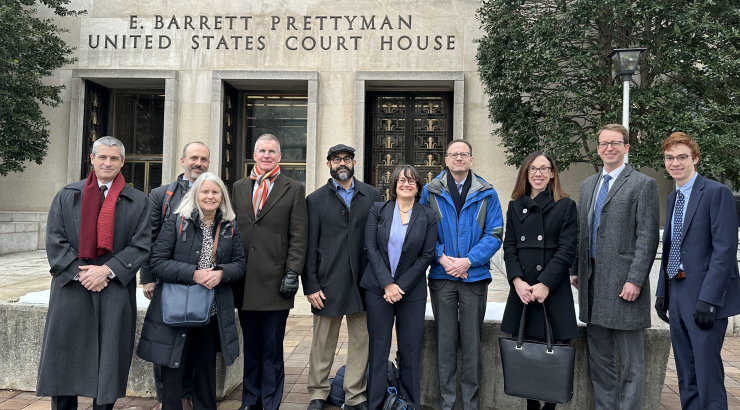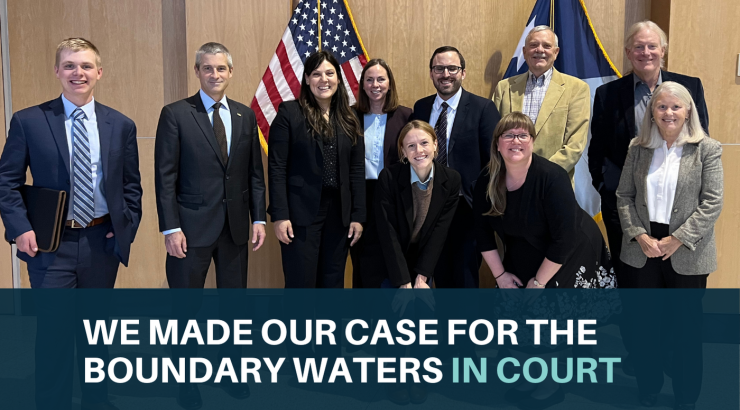We have entered into an agreement with the DNR on a process for how to move forward with review and possible revision of state mining rules. This is a first step in the right direction. The mining rules guide how sulfide-ore copper mines are sited, and we believe there should be no such mines in the BWCA watershed. Donate now to help us continue the fight to protect the Boundary Waters.

On November 18, lawyers for Northeastern Minnesotans for Wilderness (NMW) signed an agreement called a Stipulation for Remand with the Minnesota Department of Natural Resources (DNR). The stipulation agreement is a result of NMW’s lawsuit challenging the state’s non-ferrous mining rules filed pursuant to the Minnesota Environmental Rights Act (MERA) on June 24, 2020. NMW alleges that the current mining rules - adopted 27 years ago - fail to protect the Boundary Waters. The current rules allow for sulfide-ore mining in the upstream half of the Rainy River Headwaters, next to and outside of the Boundary Waters. Polluted waters from sulfide-ore copper mining in the upstream half of the Rainy River Headwaters would flow directly into the Boundary Waters and also put at risk the downstream protected areas of the Quetico Provincial Park and Voyageurs National Park (see map, below).
Donate now to help us protect the Boundary Waters in 2021!
This is the first-ever lawsuit brought under Section 10 of MERA (MS116B.10). The first step in a Section 10 MERA lawsuit provides that the plaintiff (NMW) has the burden of proving the existence of material evidence that the challenged state rules are inadequate to protect the state’s natural resources from pollution, impairment, or destruction. In other words, NMW had the burden of proving with material evidence that allowing sulfide-ore copper mining in the upstream half of the Rainy Rivers Headwaters fails to protect the Boundary Waters from pollution, impairment,or destruction. The Minnesota DNR and NMW have agreed that NMW has met this requirement of material evidence. In the stipulation agreement, the Minnesota DNR and NMW have agreed to a process to address the adequacy of the rules.
The process as provided in the stipulation agreement is as follows:
-
The DNR will provide a public comment period concerning the adequacy of the siting provisions of Minnesota’s nonferrous mining rules to protect the Boundary Waters and the Rainy River Headwaters as natural resources. The public comment period will likely be held in early 2021.
-
After reviewing the public comments, scientific evidence submitted with the comments, and any additional information available to the DNR, the DNR will issue an order and findings of fact by September 30, 2021 concerning the adequacy of the siting rule.
-
Any party to NMW’s lawsuit - and Antofagasta’s Twin Metals has intervened in the lawsuit and thus is a party - may challenge the DNR decision and request a contested case hearing, which is a trial before an administrative law judge. Therefore, we anticipate that there will be a contested case hearing on the adequacy of the nonferrous mining regulations to protect the Boundary Waters and the Rainy River Headwaters. If the administrative law judge finds that the siting section of the Minnesota nonferrous mining rules is inadequate to protect the Boundary Waters, the DNR will commence the formal rulemaking procedure to amend state regulations.
-
After final rulemaking, the matter will return to district court in Ramsey County to address any challenges by any party to the lawsuit.
The entire process for NMW’s MERA lawsuit will take several years. Success would mean that sulfide-ore mining would be prohibited in the entire Rainy River Headwaters, including and specifically the upstream half that is currently unprotected.
Help us raise $300,000 by midnight on Nov. 19! We have an incredible $150,000 match, courtesy of the Manitou Fund ($50,000), as well as a group of loyal supporters. Double your impact by making a Give to the Max Day gift!

Map of the Rainy River Headwaters watershed. The proposed Twin Metals mine is located nine miles southeast of Ely, in the watershed which flows directly into the Boundary Waters Canoe Area Wilderness, Quetico Provincial Park and Voyageurs National Park.




